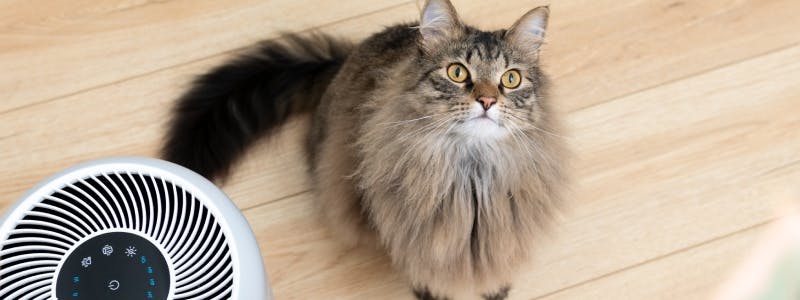
Do Air Purifiers Help with Allergies?
If you suffer from allergies, you’re probably looking for some simple ways to reduce those uncomfortable symptoms. While we know that air purifiers can reduce the amount of pollution in the air, can they help reduce allergy symptoms?1 Some studies suggest that they can.2 However, there’s more than one way to keep the air in your home clean. Learn how to ease allergy symptoms with the help of an air purifier and other ways to improve the quality of your indoor air.
What Is an Air Purifier?
Air purifiers, also known as air cleaners, help reduce the amount of pollution in the air of a designated space. They filter out the pollutants in the air that pass through them before that air re-enters the room.1
To work effectively, air purifiers need to remove extremely small airborne particles—between 0.1-1 um.4 Your air purifier, or the packaging it came in, may contain a label stating the amount of pollution it removes and what particle size it works on. For example, air cleaners that remove over 99% of air contaminants may only be missing the smallest particles.4 Typically, manufacturers use the Clean Air Delivery Rate (CADR) system to rate their purifiers’ performance.4 One of the most common filters—the High Efficiency Particulate Air (HEPA) filter—removes 99.97% of all particles over 0.3 um.4
Treating Allergies with an Air Purifier
Some studies have shown that placing an air filter in your home can reduce indoor air pollution and provide some relief from allergy symptoms .2 However, the type of air purifier you use is important, as some air cleaners have been shown to exacerbate allergies instead of relieving them.2
Ionic electrostatic room cleaners aren’t recommended for allergy sufferers as they produce an irritating ozone from the ions they release. Cheap fiberglass furnace filters can also be harmful, especially if you forget to change the filter frequently. In addition, be wary of air purifiers with allergy-relief claims. There’s no scientific evidence that air purifiers that use U.V. light—a light that kills bacteria—are useful for reducing allergies, even though they’re sometimes marketed as such.2
Removing Pet Dander with an Air Purifier
Are you showing signs of dog or cat allergies? Air purifiers are particularly useful for people with animal allergies and pets. According to the EPA, animal dander is one of the most common household irritants in the air.2 You can reduce the amount of airborne pet dander by placing an air purifier equipped with a HEPA filter somewhere in your space. They’re also effective on dust, pollen and other airborne contaminants.2
Which Air Filter Should I Choose?
If you’re only going to use it in one place, choose an air purifier with a clean air delivery rate (CADR) that matches the size of the intended room. If your home uses a central heating, ventilation and air conditioning (HVAC) system, you can help the filtration system work on the entire house by installing a better air filter. Both permanent and disposable air filters are available.2
Other Ways to Improve Your Air
If you don’t own an air purifier, there are other effective ways to reduce household pollutants and ease your allergy symptoms.2,3
- Keep the humidity level in your home below 50% and avoid vaporizers and humidifiers. Still water and wet surfaces are a breeding ground for contaminants.
- Use a vacuum cleaner with a HEPA filter to reduce dust, pet dander and other allergens. It may take a few hours before the dust settles after you vacuum.
- Don’t smoke in the house.
- Remove your coat and shoes at the door to prevent pollen from entering the house.
- Wash your pet outside to reduce the amount of pollen in your home. Don’t forget to wash your pet’s bedding as well.
- Scrub bathrooms, basements and other tiled areas to cut down on mold.
Now that you’re equipped with this knowledge, you can make small changes around your home to help ease some of your pesky allergy symptoms. If you’re looking for 24-hour allergy symptom relief, choose FLONASE Allergy Relief Nasal Spray.
Source Citations:
- Control Indoor Allergens to Improve Indoor Air Quality. Asthma and Allergy Foundation of America. https://www.aafa.org/control-indoor-allergens/. Accessed 8/17/23.
- Air Filters. American College of Allergy, Asthma, & Immunology. https://acaai.org/allergies/management-treatment/living-with-allergies/air-filters/. Accessed 8/17/23.
- Managing house dust mites. University of Nebraska-Lincoln. https://lancaster.unl.edu/pest/resources/311dusmi.pdf/. Accessed 8/17/23.
- Air Cleaners, HVAC Filters, and Coronavirus (COVID-19). US Environmental Protection Agency. https://www.epa.gov/coronavirus/air-cleaners-hvac-filters-and-coronavirus-covid-19/. Accessed 9/18/2023.